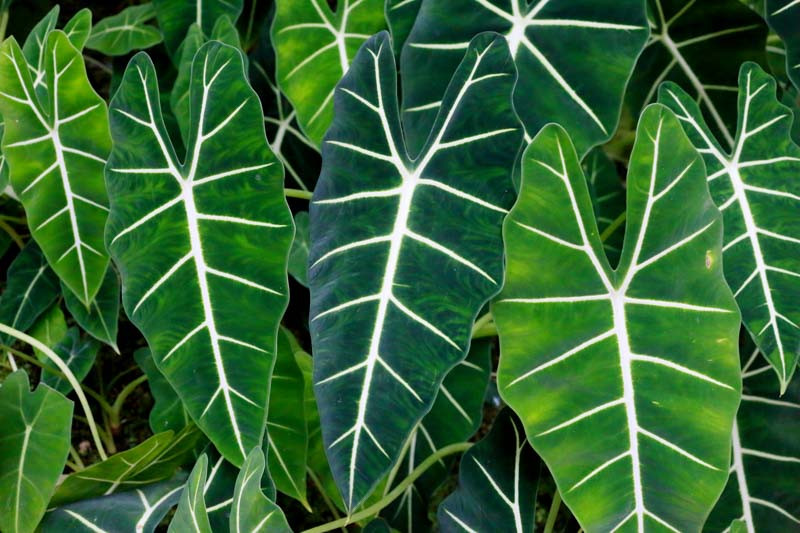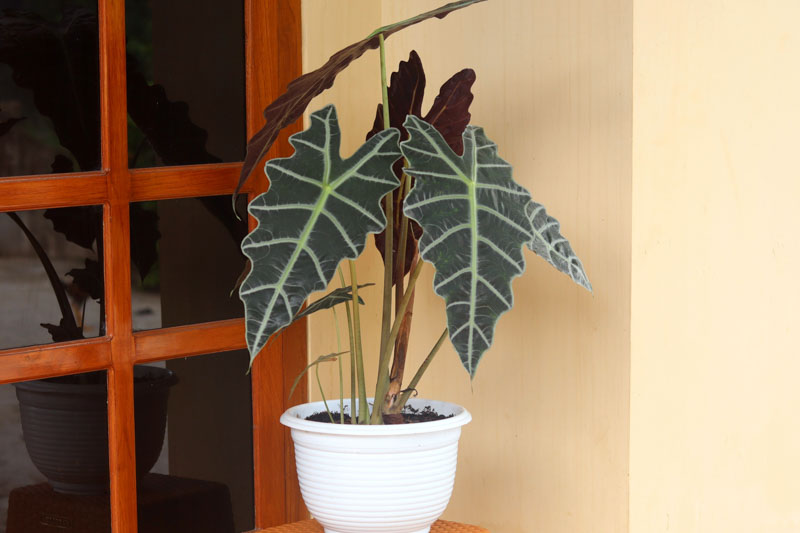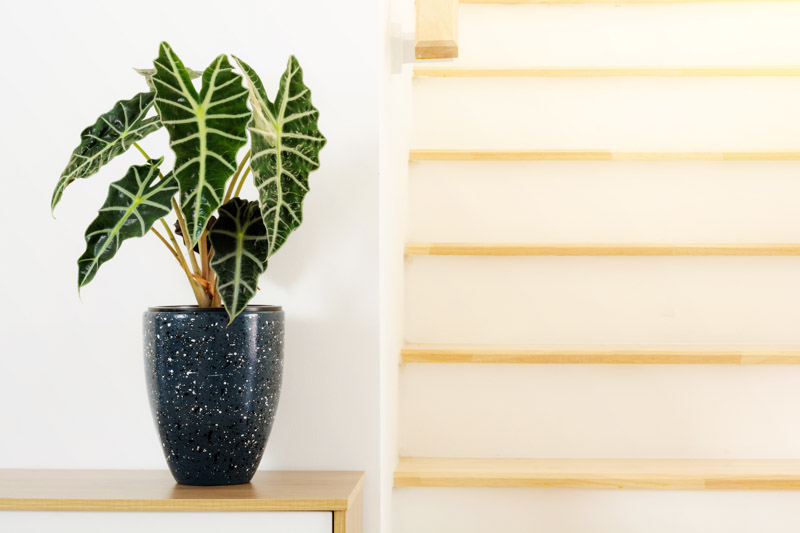Amazonian Elephant Ear, African Mask
Alocasia x amazonica, commonly known as the African Mask Plant or Amazonian Elephant Ear, is a striking hybrid that has captivated plant enthusiasts worldwide. Its exotic appearance, characterized by dark green leaves marked with bold silver veins, makes it a popular choice for indoor plant collections.
Alocasia x amazonica boasts glossy, arrow-shaped leaves that are dark green with prominent silver-white veining. The leaves have a somewhat waxy coating, contributing to their shiny appearance. Its dramatic foliage gives it a sculptural quality, making it a standout in any interior setting.
Native: Despite its name suggesting a South American origin, Alocasia x amazonica is not found in the wild. It is a hybrid created from Alocasia longiloba and Alocasia sanderiana and was developed for ornamental purposes. Alocasia belongs to the Araceae family, commonly known as the Arum family. This diverse family includes other well-known plants like Zantedeschia (Calla Lily), Caladium (Angel Wing), and Monstera (Swiss Cheese Plant).
Plant Type and Habit: It is a robust rhizomatous evergreen perennial, primarily grown as a houseplant in most regions due to its tropical origins and sensitivity to cold temperatures. Alocasia x amazonica has an upright, clumping growth habit, with each new leaf emerging from a central rhizome.
Size: The plant typically reaches 1-2 feet in height (30-60 cm) and spread, making it suitable for indoor spaces. Its compact size allows it to fit well on tabletops, shelves, or as part of a larger indoor garden arrangement.
Flower: Reminiscent of calla lily flowers, yellow flowers appear sporadically amid the boldly patterned leaves on older plants. However, flowering is rare in indoor conditions.
Foliage: The plant’s most notable attribute is its dark green, narrowly arrow-shaped, wavy-edged leaves, which can grow up to 24 inches long (60 cm). The deep green color contrasted with silver or white veining creates a visually captivating display.
Hardiness: This hybrid is tender and best suited to USDA zones 10-12 if planted outdoors. It requires indoor protection in cooler climates, thriving at temperatures between 65°F and 75°F (18°C to 24°C). African Mask plants are truly tropical plants – they appreciate lots of warmth, humidity, and water.
Award: Recipient of the prestigious Award of Garden Merit of the Royal Horticultural Society.
Uses: Alocasia x amazonica is primarily used as an ornamental plant. Its bold, decorative leaves add a dramatic touch to home decor, office spaces, and any setting where a splash of natural beauty is desired.
Toxicity: Alocasia plants are toxic if ingested, containing calcium oxalate crystals that can cause irritation of the mouth, throat, and stomach in humans and pets.
Benefits: Like many houseplants, it can help improve indoor air quality.

Growing and caring for Alocasia amazonica, also known as the African Mask Plant, requires understanding its needs to mimic its native tropical environment. This exotic plant, with its striking dark green leaves and prominent silver veins, can be a captivating addition to your indoor plant collection when its specific care requirements are met.
Light: Alocasia x amazonica thrives in bright, indirect light. Place it near a window where it can receive plenty of light but is shielded from the harsh midday sun, which can scorch its leaves. An east or north-facing window is ideal.
Soil: Use a well-draining, aerated potting mix rich in organic matter. A mixture containing peat moss, perlite, and pine bark is suitable, providing the roots with the right balance of moisture retention and air circulation.
Water: Water your Alocasia when the top 1-2 inches of soil feel dry to the touch. It prefers the soil to be consistently moist but not waterlogged, as standing water can lead to root rot. Reduce watering in the winter months when the plant’s growth slows.
Temperature and Humidity: Keep your plant in a warm environment, ideally between 65°F and 75°F (18°C to 24°C). Alocasia amazonica is sensitive to cold and should be protected from drafts and sudden temperature changes. High humidity levels are crucial for keeping Alocasia amazonica healthy, as it mimics its natural rainforest habitat. Aim for 60% humidity or higher. You can increase humidity by placing a humidifier nearby, setting the plant on a pebble tray filled with water, or misting the leaves regularly.
Fertilization: Feed your plant with a balanced, water-soluble fertilizer diluted to half strength every month during the growing season (spring through summer). Do not fertilize in the winter when growth naturally slows.
Pruning: Prune away any yellowed or damaged leaves to encourage new growth and maintain the plant’s appearance. Use clean, sharp scissors or pruning shears to make clean cuts.
Cleaning: Regularly wipe the leaves with a damp cloth to remove dust and inspect for pests, as this will also help the plant to photosynthesize more efficiently.
Repotting: Repot Alocasia amazonica every 2-3 years or when it becomes root-bound. Choose a pot that’s only slightly larger than the previous one, as too much space can lead to excess soil moisture, increasing the risk of root rot.

Propagating Alocasia x amazonica, also known as the African Mask Plant, is usually done through division, as this plant does not typically produce viable seeds for cultivation. Propagation through division involves separating the plant’s rhizome (underground stem) into multiple parts, each with at least one growth point.
Best Time for Propagation: The optimal time for propagating Alocasia x amazonica is during the spring or early summer, which aligns with the plant’s active growing period.
Prepare: Gather all your materials and ensure your knife or shears are sterilized to prevent the spread of disease.
Unpot the Plant: Carefully remove the Alocasia x amazonica from its pot, gently shaking off excess soil to expose the rhizome.
Identify Division Points: Look for natural divisions in the rhizome where there are distinct growth points (nodes) with attached roots.
Divide the Rhizome: Using your clean, sharp knife or shears, cut the rhizome into sections, ensuring each section has at least one growth point and a healthy root system.
Pot the Divisions: Plant each division in its own pot filled with the appropriate potting mix. The pot size should be just large enough to accommodate the roots and allow for future growth.
Water and Care: Water the newly potted divisions lightly to settle the soil around the roots. Place them in an area with bright, indirect light and maintain high humidity around the plants, similar to the parent plant’s original growing conditions.

While stunning, Alocasia plants can encounter several pests, diseases, and common problems, especially when their growing conditions are not optimal.
Spider mites: These tiny pests thrive in dry conditions and can cause the foliage to look dull and stippled. Increase humidity and wash the plant with water. In severe cases, use insecticidal soap or neem oil.
Mealybugs: Recognizable by their cotton-like white masses, they suck plant sap, weakening it. Remove them manually using a cotton swab dipped in rubbing alcohol or apply insecticidal soap.
Aphids: These small, green pests suck sap from new growth. Rinse them off with water or treat the plant with neem oil.
Scale insects: These can appear as small brown bumps on the stems and leaves, sucking the sap and reducing plant vigor. Scrape them off or treat them with neem oil.
Root rot: Overwatering is the primary cause, leading to soggy soil conditions where fungi thrive. Ensure the soil is well-draining and reduce watering frequency.
Leaf spot: Fungal and bacterial infections can cause spots on leaves. Improve air circulation, avoid wetting foliage when watering, and remove affected leaves. Fungicides may be required in severe cases.
Yellowing Leaves: Over- or underwatering can lead to yellow leaves. Adjust watering practices to ensure the soil is moist but not waterlogged.
Drooping Leaves: This can be a sign of either too much or too little water, extreme temperatures, or inadequate light. Assess the growing conditions and make necessary adjustments.
Brown Leaf Edges: Low humidity or salt build-up from fertilizers can cause crispy edges on leaves. Increase humidity around the plant and flush the soil with water periodically to remove excess salts.
| Hardiness |
10 - 12 |
|---|---|
| Climate Zones | 22, 23, 24, H1, H2 |
| Plant Type | Houseplants, Perennials |
| Plant Family | Araceae |
| Genus | Alocasia |
| Common names | Elephant Ear |
| Exposure | Partial Sun |
| Season of Interest |
Spring (Early, Mid, Late) Summer (Early, Mid, Late) Fall Winter |
| Height |
1' - 2' (30cm - 60cm) |
| Spread |
1' - 2' (30cm - 60cm) |
| Spacing | 24" (60cm) |
| Maintenance | Low |
| Water Needs | Average |
| Soil Type | Loam |
| Soil pH | Acid, Neutral |
| Soil Drainage | Moist but Well-Drained |
| Characteristics | Plant of Merit, Showy, Evergreen |
| Garden Uses | Beds And Borders, Patio And Containers |
| Garden Styles | Mediterranean Garden |
| Hardiness |
10 - 12 |
|---|---|
| Climate Zones | 22, 23, 24, H1, H2 |
| Plant Type | Houseplants, Perennials |
| Plant Family | Araceae |
| Genus | Alocasia |
| Common names | Elephant Ear |
| Exposure | Partial Sun |
| Season of Interest |
Spring (Early, Mid, Late) Summer (Early, Mid, Late) Fall Winter |
| Height |
1' - 2' (30cm - 60cm) |
| Spread |
1' - 2' (30cm - 60cm) |
| Spacing | 24" (60cm) |
| Maintenance | Low |
| Water Needs | Average |
| Soil Type | Loam |
| Soil pH | Acid, Neutral |
| Soil Drainage | Moist but Well-Drained |
| Characteristics | Plant of Merit, Showy, Evergreen |
| Garden Uses | Beds And Borders, Patio And Containers |
| Garden Styles | Mediterranean Garden |
How many Alocasia x amazonica (African Mask) do I need for my garden?
| Plant | Quantity | |
|---|---|---|
| Alocasia x amazonica (African Mask) | N/A | Buy Plants |
Create a membership account to save your garden designs and to view them on any device.
Becoming a contributing member of Gardenia is easy and can be done in just a few minutes. If you provide us with your name, email address and the payment of a modest $25 annual membership fee, you will become a full member, enabling you to design and save up to 25 of your garden design ideas.
Join now and start creating your dream garden!
Create a membership account to save your garden designs and to view them on any device.
Becoming a contributing member of Gardenia is easy and can be done in just a few minutes. If you provide us with your name, email address and the payment of a modest $25 annual membership fee, you will become a full member, enabling you to design and save up to 25 of your garden design ideas.
Join now and start creating your dream garden!